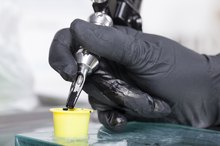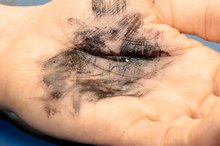Is Ballpoint Pen Ink Toxic?
Ballpoint pens are extremely popular with children because they come in a variety of colors and sizes. Ink poisoning is a common fear for parents who have school age children that use ink pens to write or draw on skin and other common objects.
Toxicity
All ballpoint pens are made with non toxic ink. The manufacturing and content of the pens are regulated in most countries. In the past ink poisoning has been a huge concern of parents with young children that may draw on themselves or have ink rub off of paper onto their hands and arms. Luckily, this is not a problem with ballpoint pen ink.
- All ballpoint pens are made with non toxic ink.
- The manufacturing and content of the pens are regulated in most countries.
Modern Use
Side Effects of Ant Poison
Learn More
It is popular for school age children to tattoo themselves with ballpoint pens. Ballpoint pens come in various colors, including neon and white, and are capable of creating intricate and colorful, though temporary, ballpoint tattoos. The ink is non toxic and this fact makes the popularity of the pen no longer a safety issue.
Ink Removal
Stop the ink from spreading. Ballpoint pens work in a way in which the liquid flows out past the ball, causing the ink to spill out and create large blotches when held in the same position. The pen may also explode and damage material. The first thing to do is to stop the spreading of the ink on the fabric with a mixture of 50 percent of ammonia and 50 percent hydrogen peroxide. Spray this mixture onto the area and the ink will stop spreading. Then use the cleaning solvent of your choice and apply it to the stain. Rubbing the solvent in should not spread the ink since it is trapped by the combination of ammonia and hydrogen peroxide. For those in a hurry, blotting rubbing alcohol on the stain can remove it rapidly.
- Stop the ink from spreading.
- Ballpoint pens work in a way in which the liquid flows out past the ball, causing the ink to spill out and create large blotches when held in the same position.
Ink Poisoning
Nontoxic Tattoo Ink Ingredients
Learn More
Poisoning ingredients found in pens are a mixture dyes, pigments, solvents and water. They are usually found in bottled ink and certain, (usually older brands) of ink pens. The symptoms of poisoning are eye irritation, staining of the skin and other mucus membranes. Large amounts of ink must be ingested before poisoning may occur. If poisoning does occur, do not induce vomiting. It may be helpful to wash the ink from skin if any is present. Ink poisoning is extremely rare simply because of the amount of ink that must be ingested.
- Poisoning ingredients found in pens are a mixture dyes, pigments, solvents and water.
- Large amounts of ink must be ingested before poisoning may occur.
Conclusion
Ink poisoning does occur rarely. New technologies as well as new pen designs and manufacturing standards make it largely a fear that belongs in the past. Though writing or “tattooing” on oneself is not necessarily healthy, it would still take large amounts of chemical ingestion to truly become sick. If you fear ink poisoning or any other chemical interactions that could occur through the misuse of writing utensils research the product prior to purchase.
- Ink poisoning does occur rarely.
- If you fear ink poisoning or any other chemical interactions that could occur through the misuse of writing utensils research the product prior to purchase.
Related Articles
References
Writer Bio
Megan Allyce Snider is a freelance writer who has contributed to a variety of websites. Snider holds a Bachelor of Arts in English from Jacksonville State University and an Associate of Arts in liberal arts from Muscatine Community College. She has also studied German and English at Shorter College.









